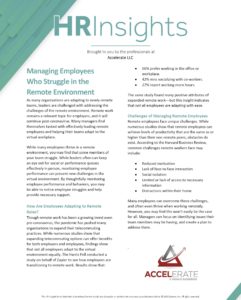As many organizations are adapting to newly remote teams, leaders are challenged with addressing the challenges of the remote environment. Remote work remains a relevant topic for employers, and it will continue post-coronavirus. Many managers find themselves tasked with effectively leading remote employees and helping their teams adapt to the virtual workplace.
While many employees thrive in a remote environment, you may find that some members of your team struggle. While leaders often can keep an eye out for social or performance queues effectively in person, monitoring employee performance can present new challenges in the virtual environment. By thoughtfully monitoring employee performance and behaviors, you may be able to notice employee struggles and help provide the necessary support.
How Are Employees Adapting to Remote Roles?
Though remote work has been a growing trend even pre-coronavirus, the pandemic has pushed many organizations to expand their telecommuting practices. While numerous studies show that expanding telecommuting options can offer benefits for both employers and employees, findings show that not all employees adapt to the virtual environment equally. The Harris Poll conducted a study on behalf of Zapier to see how employees are transitioning to remote work. Results show that:
- 66% prefer working in the office or workplace.
- 42% miss socializing with co-workers.
- 27% report working more hours.
The same study found many positive attributes of expanded remote work—but this insight indicates that not all employees are adapting with ease.
Challenges of Managing Remote Employees
Remote employees face unique challenges. While numerous studies show that remote employees can achieve levels of productivity that are the same as or higher than their non-remote peers, obstacles do exist. According to the Harvard Business Review, common challenges remote workers face may include:
- Reduced motivation
- Lack of face-to-face interaction
- Social isolation
- Limited or lack of access to necessary information
- Distractions within their home Many employees can overcome these challenges, and often even thrive when working remotely.
However, you may find this won’t easily be the case for all. Managers can focus on identifying issues their team members may be having, and create a plan to address them.
Identifying Employees Who Are Struggling to Work Remotely
When physically present, leaders often can identify an instance of when an employee’s performance or well-being seems to suffer. In the remote environment, there are cues leaders can look for, and topics to consider:
- What if a high performer’s motivation disappears? When an employee who is known to be an eager, high-performing team member has a sudden drop in productivity or is struggling to meet deadlines, consider whether there has been a recent change:
- Has there been an organizational change?
- Has there been a change in their personal life?
- Has their workload or responsibilities changed?
A decrease in performance could be due to a variety of reasons—these may be some clues for managers to use when uncovering an unforeseen issue one of their team members may be encountering.
- What about your organization or team is worse than before? A remote work environment can bring issues to light, such as a process that could use improvement. Consider whether an employee’s struggles may be part of a broader structural, leadership or organizational issue.
While some issues may be unavoidable, leaders can be proactive by establishing clear expectations and accountability for each employee. As problems are encountered, be prepared to not only support employees in need but also evaluate and change structural issues.
Managing Employees Who Are Struggling in the Remote Environment
Managers can take steps to help employees. Considerations include:
- Schedule one-on-one check-ins with each team member—By gauging how each employee is doing, leaders can evaluate how to meet the unique needs of each employee. Asking open-ended questions can allow employees to speak their minds. Leaders should focus on being good listeners and providing appropriate support.
- Offer empathy, but avoid lowering expectations—Ensure that each employee knows they are a critical member of the team. Acknowledge their current struggles and create a plan to get back on track.
- Challenge employees to make an impact—Consider how workload adjustments—including assignments that include problem-solving or experimentation may reengage an employee who, though may be talented, is struggling in the current environment.
- Meet individual needs, but don’t show favoritism—It can be a fine line between supporting individual needs and avoiding perceived favoritism that may cause others on your team to feel remorse. Consider how establishing team policies and expectations might benefit the whole group.
- Offer support—A decrease in performance can be a failure of both the employee and leadership. Take accountability in the situation and offer solutions for how the employee can be better supported.
Remember, each employee is unique. Some employees may adapt well to a remote environment, while others may need individual support to achieve a high level of performance and personal well-being.
Empower Success in the Remote Workplace
Every business is different, so there isn’t one right way to best lead remote employees. Create practices and expectations that work best for your team. Contact us for additional resources regarding best practices for utilizing the remote workplace.
This HR Insights is not intended to be exhaustive nor should any discussion or opinions be construed as professional advice. © 2020 Zywave, Inc. All rights reserved.


